2012 VOLKSWAGEN GOLF MK6 keyless
[x] Cancel search: keylessPage 110 of 516
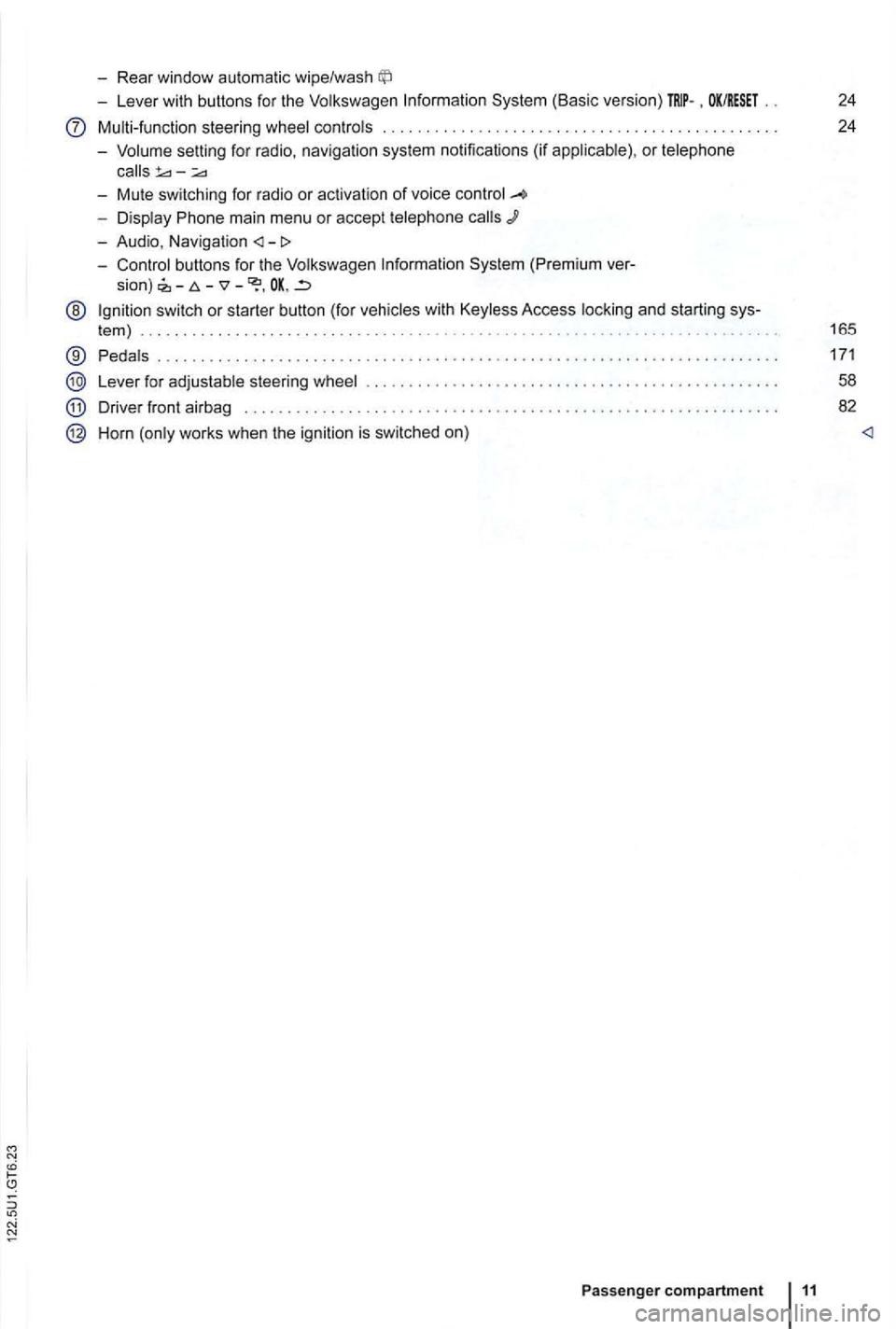
-Rear window automatic wipe/wash
-Lever with buttons for the Volkswagen Information System (Basic version) . OK/RESET 24
Multi-function steering wheel controls . . . . . . . . . . . . . . . . . . . . . . . . . 24
- Volume setting for radio , naviga
tion system notifications (if applicab le) , or telephone
- Display Phone main menu or accept telephone
- Audio, Navigation
sion) -
@ Ign ition switch or starter button (for vehicles with Keyless Access locking and starting sys-
tem ) . . . . . . . . . . . . . . . . . . . . . . . . . . . . . . . . . . . . . . . . . . . . . 165
® Pedals ............ .................................... ....................... .
Lever for adjustable steering wheel
Driver front airbag . . . . . . . . . .
.............................................. .
Horn (only works when the ignition is switched on)
Passenger compartment 11
171
58
82
Page 140 of 516
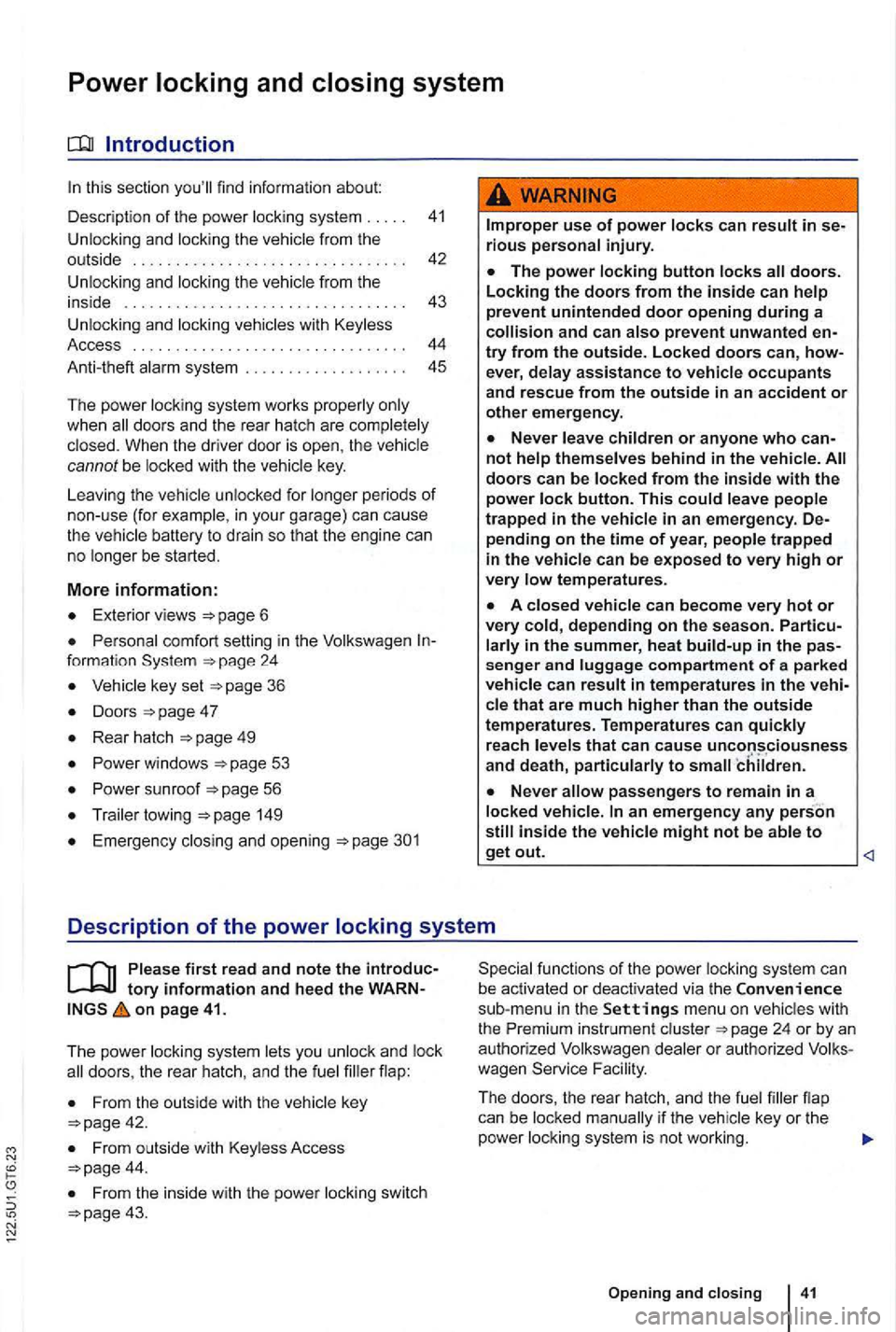
Power locking and closing system
Introduction
this section find information about:
Description of the power locking system .
41
Unlocking and locking the
Exterior views 6
Persona l comfort setting in the Volkswagen formation
Veh icle key set 36
Doors
Rear hatch 49
Power windows
Power sunroof 56
149
Emergency closing and opening
can result in se
rious personal injury.
The power locking button doors. Locking the doors from the inside can
assistance to vehicle occupants and rescue from the outside in an accident or other emergency.
children or anyone who cannot doors can be locked from the inside with the power button. This people trapped in the vehicle in an emergency. De
pending on the time of year, people trapped in the vehicle can be exposed to very high or very temperature s.
A closed vehicle can become very hot or very depending on the season. Particuin the summer, heat build-up in the pas
senger and luggage compartment of a parked vehicle can result in temperatures in the vehithat are much higher than the outside temperatures. Temperatures can quickly reach
Never passengers to remain in a
locked vehicle. an emergency any person inside the vehicle might not be
Description of the power locking system
on page 41.
The power lock
ing system you unlock and lock doors , the rear hatch , and the flap:
From outside with Keyless Access
From the inside with the power locking switch
fun ctions of the power locking system can
be activated or deac tivated via the Convenience
sub-menu in the Settings menu on
Facility .
The doors,
the rear hatch, and the fuel
Page 143 of 516
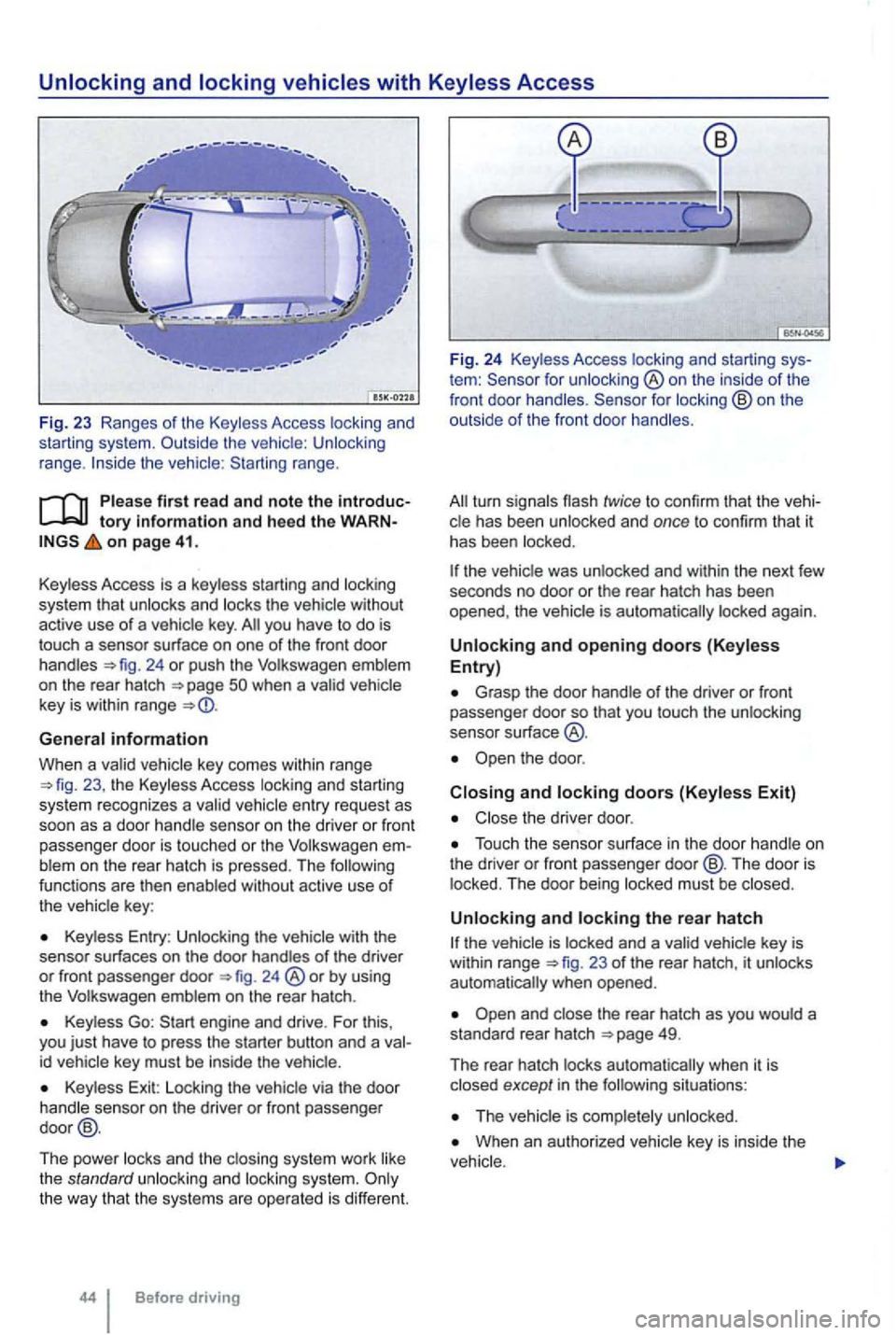
range.
tory information and heed th e o n page 41.
Key less Access is a key less starting and locking
system that
unlocks and locks the vehicle without
active use of a vehicle key. you have to do is
touch a sensor surface on one of the front door
handles 24 or push the Volkswagen emblem
on the rear hatch
General information
When a va lid ve hicl e key comes within range 23 , the Keyless Access locking an d starting
sys tem recognizes a va lid vehicle entry reques t as
soon as a doo r hand le se nso r on the driver or front
passenger door
is touched or the Volkswage n blem on the rear hatch is pressed. The functions are then enab led without active use of
the vehic le key :
Keyless Entry : Unlocking the with the
senso r surf aces on the door handles of the driver or front passenger door 24 ®or by using
the Volkswagen emblem on the rear hatch .
Keyless Go:
id vehicle key must be inside the vehic le.
Key less Exit: Locking the vehicle via the door
handle sensor on the driver or front passenger
door @.
The power locks and th e clos ing system work like
the standard unlocki
ng and locking system.
tem : for unlocking ®on the inside of the
front door handles .
the vehic le was unlocked and within the next few
seco nds no door or the rear hatch has been
opened , the vehic le is aut oma tically locked again.
Unlocking and opening doors (Keyless Entry)
Grasp the door handle o f the driver or fron t passe nger door so that you touch the unlocking
sensor su rface
the door .
Closing and locking doors (Keyless Exit)
Close the driver door .
Touch the sensor surface in the door handle on
the dri ver or front passenger door@ . The door is
locked . The door being locked must be closed .
Unlocking and locking the rear hatch
23 of the rear hatch, it unlocks
automatically when opened.
situations :
When an authorized vehicle key is inside the
Page 144 of 516
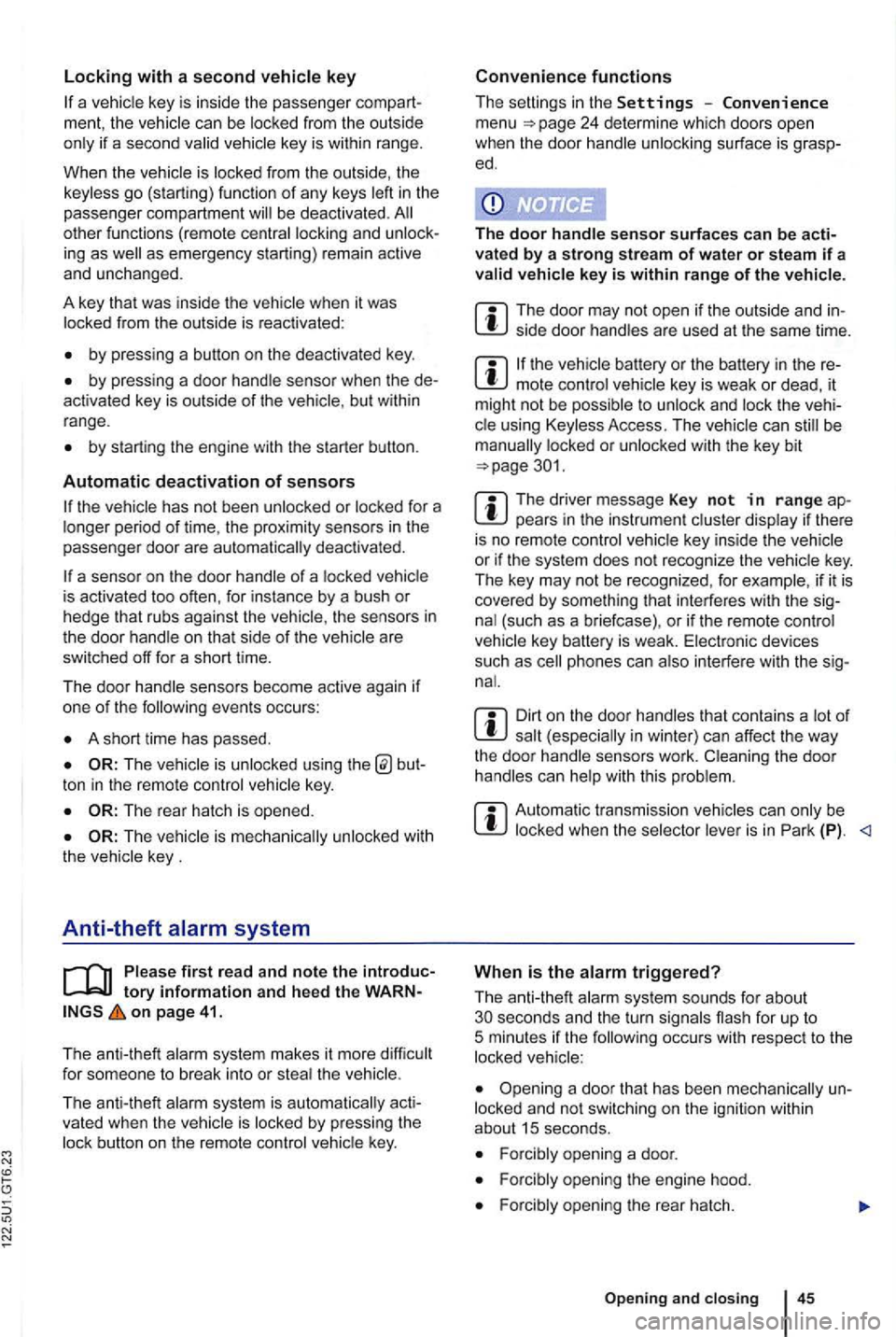
N
if a seco nd valid
by press ing a button on the deactivated key.
by pressing a door handle sensor when the de
activated key is outside of the vehicle , but with in
range .
by starting the engine with the starter butto n.
Automatic deactivation of sensors
deactivated .
is activated too often, for instance by a bush or hedge that rubs against the the sensors in the door handle on that side of the vehicle are
switched off for a short time.
T he door handle sensors become active again if
one of the even ts occurs:
A short time has passed.
The rear hatch is opened .
The key .
Anti-theft
tory information and hee d the WARN on page 41.
T he anti-theft alarm system makes it more difficult
for someon e to break into or steal the veh icle .
The anti-theft alarm system is
key i s within range of the vehicle.
T he door may not open if the outside and in side door handles are used at the same time.
the vehicle battery or the battery in the remote control vehicle key is weak or dead , it
might not be possible to unlock and using Keyless Access. The vehicle can locked or unlocked with the key bit
The driver message Key not in ra nge ap pears in the instrument cluster display if there
is no remote control vehicle key inside the vehicle
or if the system does not recognize the
key. The key may not be recognized , for example, if it is
covered by something that interferes with the sig
(such as a briefcase) , or if the remote control
vehicle key battery is weak. Electronic devices
such
as phones can interfere with the sig
Dirt on the door handles that conta ins a of in winter) can affect the way
the door handle sensors work.
with this problem .
Automatic transmissio n vehic les can
Opening a door that has been un
locked and not switching on the igni tion with in
about 15 seconds.
Forcibly opening a door.
Forcibly opening the engine hood.
Forcib ly opening the rea r hat ch.
and closi ng 45
Page 266 of 516
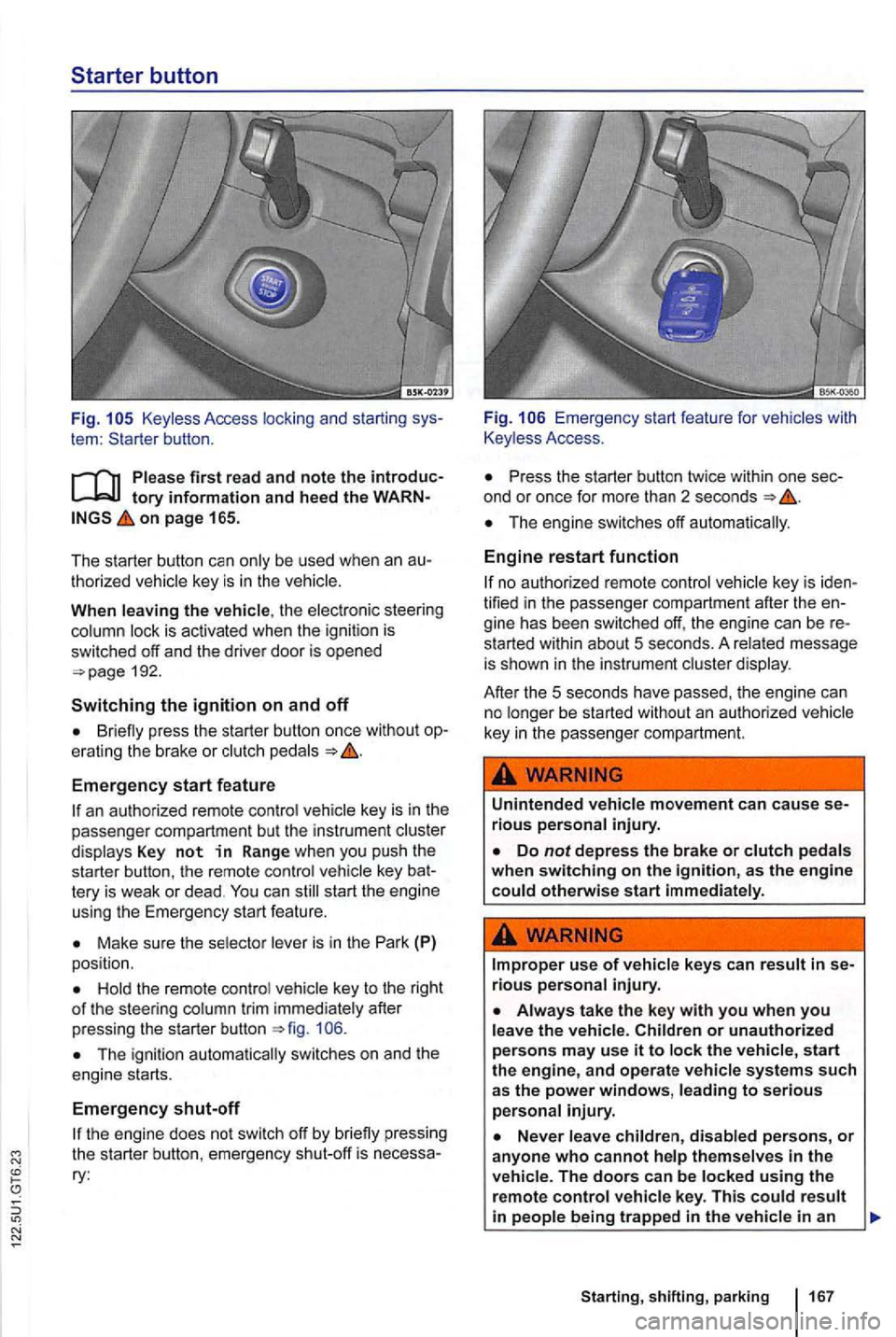
Keyless Access locking and starting sys
tem :
on page 165.
The starter button
be used when an au
t horized
the elec tronic steering is ac tivated when the ignit io n is
swi tched off and the driver door is opened
192.
Switching the ignition on and off
press the starter button once without op
e rating the brake or
Emergency start feature
an authorize d remote veh icle key is in the
passenger compartment but the inst rume nt
can
Make sure the
key to the right of the steering trim immed iate ly after
p ressing the starter button
the
eng ine starts.
Emergency shut-off
the engine does not switch off by
Press the starte r butt on twice within one sec
ond or once for more than 2 secon ds
Engine restart function
no author ize d r emote control veh ic le key is iden
tified in the passenger compartmen t afte r the en
gine has been switched off, the engin e can be re
s tarted wi
thin about 5 seconds . A rela ted message
is sh ow n in the instrument cluster displa y.
Afte r the
5 seconds have passed, the engine can
n o be started without an author ized ve hicle
key in the passenger compartment.
Unintended
in se
rious
start th e engine, and operate vehicle systems such as the power windows,
The doors can be
Starting, shifting, parking 167
Page 268 of 516

Major con sumers of are sw itched off when the engine is being started .
Stopping the engine
After start ing a engin e, there may be creased operating noises fo r a few seconds .
This is
first read and note the introductory information and heed the on
perform each step
without Keyless Access Vehicles with Access
1. Bring the to a
2. Dep res s and down the brake s tep 4 is
3 . A ut omatic transmission: th e transmission into Park (P) .
4 .
the parking brake to fr om moving
in Briefly press the starter button 167. 5. the engine 167.
6 . With
a
tran smi ssion , shift into 1st gear or re-
ve rse pointin g down hill).
Never stop the engine before the has
come to a trol of the vehicle, crash, and be
be needed to stop the
not be able to steer the
the engine
running and the driver door is opened, a
c him e sounds. Th e c hime is a re minder to
sw itch off the engine and turn off the igniti on before and from the outside.
with automatic t ransmissio ns. the be remov ed from the
ignition when the transmission is in Park (P).
After the engi ne has been switched off. the radiato r fan in the engine compartment may
keep running for ning after the even if the ignition is sw itche d off and t he ve hicle
key has bee n remo ved. Th e radiat or fan sh uts off
automatically when th e engine has down
enough.
Starting, shifting, parking 169
Page 269 of 516
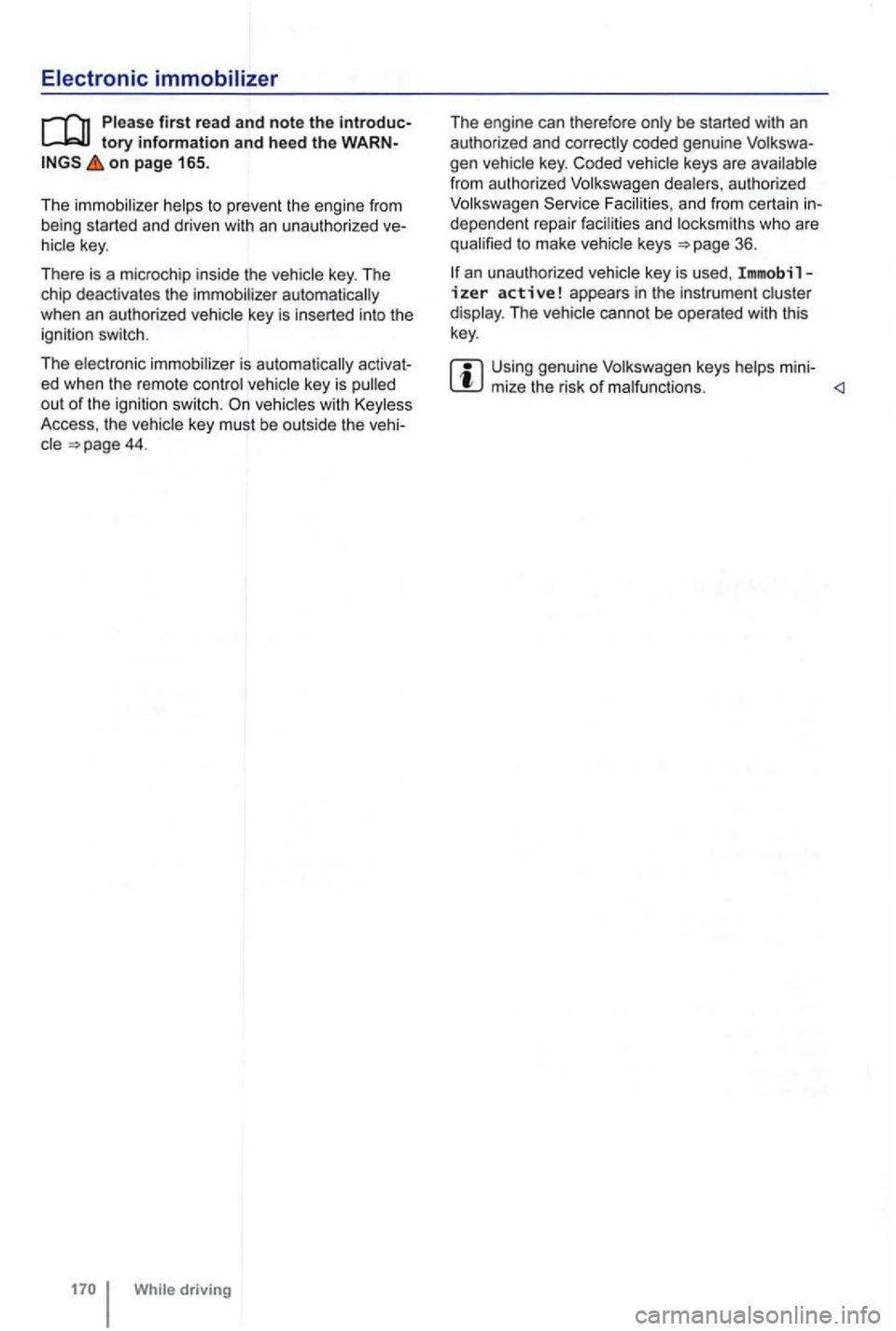
on page 165.
The immobilizer helps to pre ve
nt the engine fr om
being started and driven with an unauth orized
vehicles with Keyless
Access , th e vehicle key must be outside the
driving The
engine can therefore
dependent repair facilities and locksmiths who are to make vehicle keys 36.
an unauthorized vehicle key is used , Immobilizer active! appears in the instr ument cluste r
display . Th e
Using genuine mize the risk of malfun ctions .
Page 322 of 516
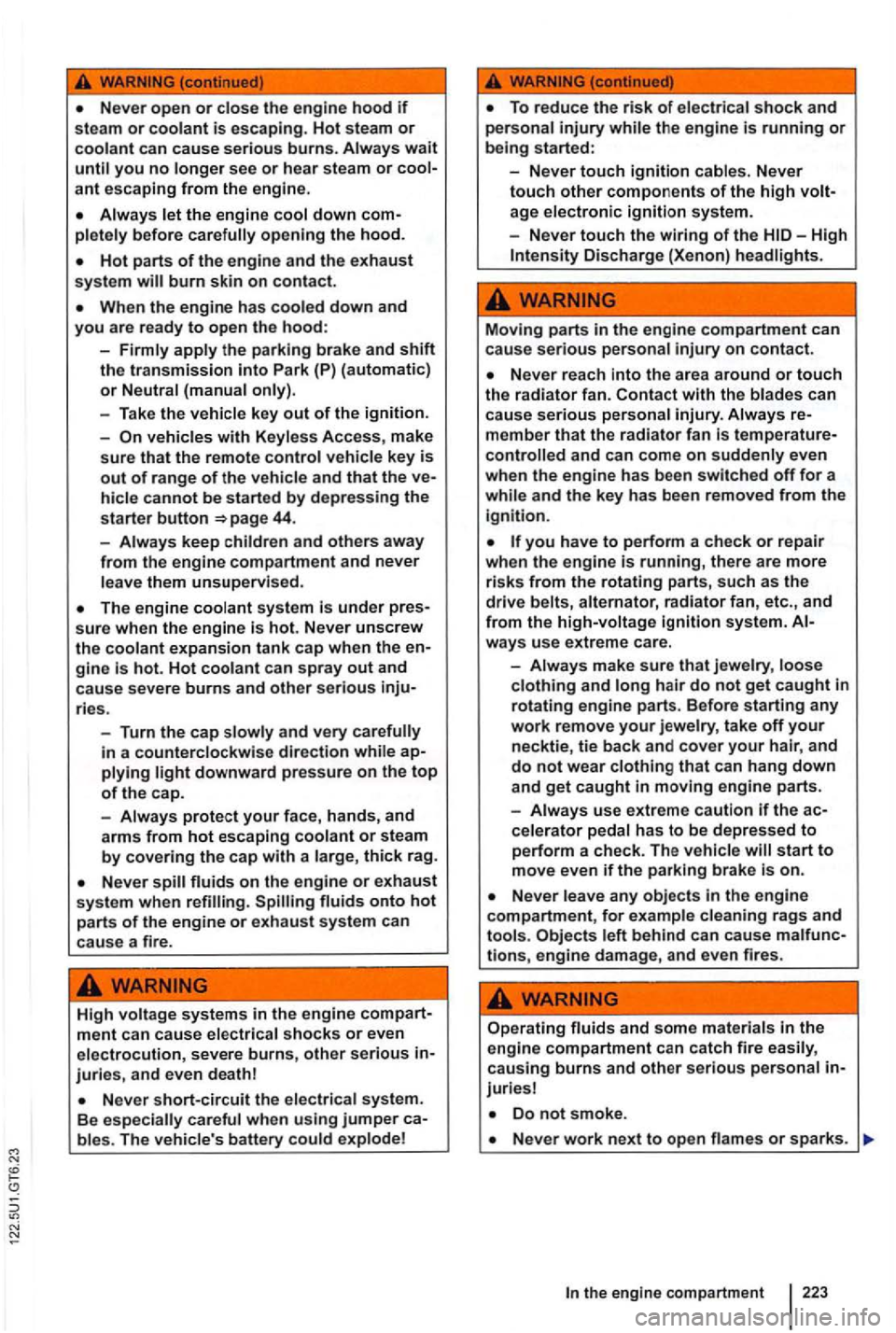
Never open or close the engine hood if To reduce th e risk of electrica l shock and steam or coolant is escaping. Hot steam or personal injury
-Never touch ignition cables. Never ant escaping from the engine. touch other components of the high
Always the eng ine down com-age electronic ignition syste m .
opening the hood.
-Never touch the wiring of the Discharge (Xenon) headlights.
system burn skin on contact.
you are read y to open the hood: Moving parts in th e engine compartment can
- Firm ly apply the parking brake a nd shift cause serious personal injury on contact. the transmission into Park (P) (automatic)
vehicles with Keyless Access, make member that the radiator fan is temperature-
s
ure that the remote contro l vehicle key is controlled and can come on sudden ly even
out of range of th e vehicle and that the ve- when the engine
has been switched off for a
hicl e cannot be started by depres sing the 44. ignition.
-
Always keep children and others away you have to perform a check or repair from the engine compartment and never when the engine is runn ing, there are more leave them unsupervised. risks from the rotating parts, such as the
hair do not get caught in
ries. rotating engine
parts. B efore starting an y
- Turn
the cap
fluids onto hot parts of the engine o r exhaust system can
cause a fire. -
Always use
extreme caution if the ac-
ce lerato r pedal has to be depressed to perform a check. The vehicle will start to move even if the parking brake i s on.
Never leave any objects in the engine compartment, for examp le cleaning rags and tools. Objects left b ehind can cause malfunc-lions, engine damage, and even fires.
High voltage sy stems in the engine com part-ment can ca use electrica l shocks or even
electrocution, severe burns, other serious in-juries, and eve n deathl
Neve r short-circuit the electrica l syste m .
B e especially ca reful when using jumper ca-
Operating fluids and some materials in the engi ne compartment can catch fire easily, causing burns an d other serious personal in-juries
Do not smoke .
b les. The
vehicle 's battery could exp lode! Never work next to open flames or sparks .
223